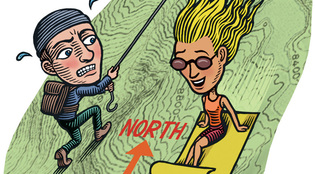 loading
loading
FindingsThis side up Gregory NemecView full imageIt was a coworker of Joseph P. Simmons’s mother who inspired his latest marketing paper. She mentioned that her proposed bike trip from Maine to Florida would be a piece of cake because the route was “all downhill.” “On Southbound Ease and Northbound Fees” suggests that a lifetime of looking at maps in which north points up has influenced the way many think about distances and directions. In a series of studies published in the Journal of Marketing Research, Simmons and a coauthor found that people generally assume it will take longer to travel north, are more likely to cash in a coupon if it’s for a store south of them, and think that moving companies charge more when transporting furniture north than south. Simmons, an assistant professor of marketing at the School of Management, says the studies don’t mean that people consciously believe it’s harder to go north than south, but rather that their thinking can be influenced subconsciously by the pervasive association between north and up. “If you press them, they would deny believing this,” Simmons says. “It just shows that metaphors we use in everyday life affect our thinking and affect the choices we make.” Simmons is still puzzling out the implications. The finding could explain the ubiquity of “come on down” slogans for discount merchants: if consumers perceive a “down” location as an easier trip, they may be more likely to visit. It likely means that advertisements should emphasize their southern orientation whenever possible. Simmons’s discovery also supports the growing consensus that when humans think, we use perceptual cues and mental maps—and metaphors—instead of words and strict logical rules. “Our perceptual world is part of our way of thinking,” he says.
The comment period has expired.
|
|